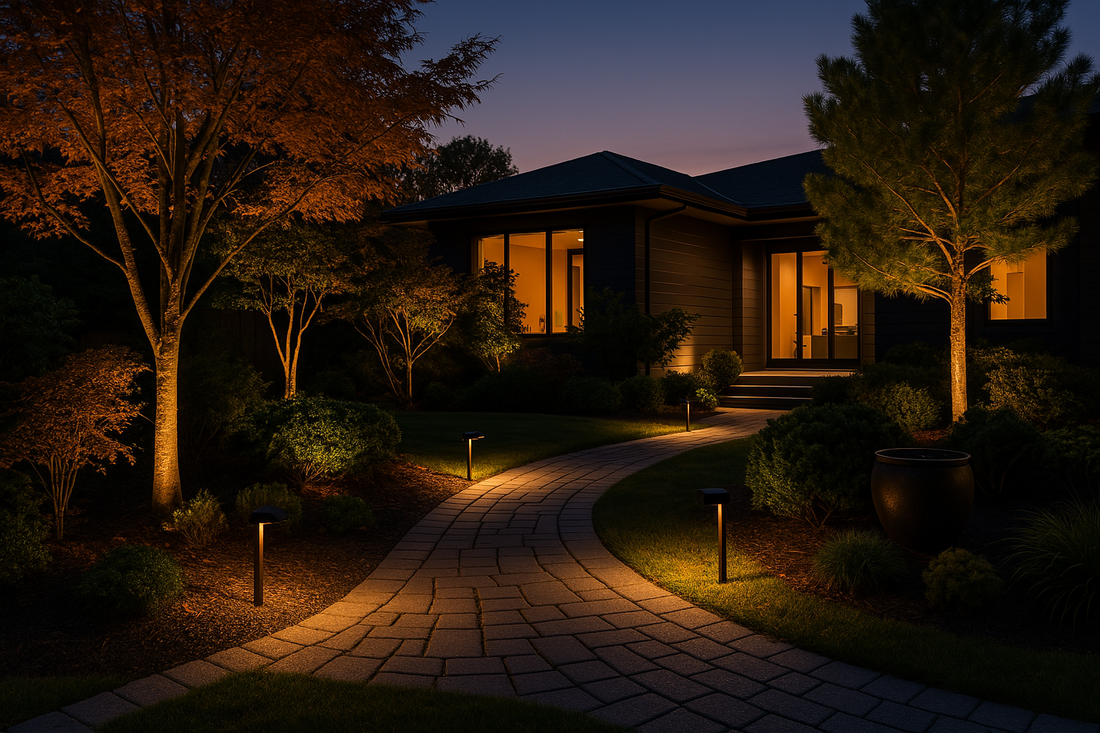
Bright Savings: How 12V Low Voltage Lighting Saves Energy and Money
Share
Introduction
When it comes to outdoor lighting, homeowners often look for solutions that are beautiful, functional, and cost-effective. One of the smartest choices you can make is switching to 12V low voltage lighting. Not only does it enhance your home’s curb appeal and safety, but it also delivers significant energy savings compared to traditional 110V systems.
Think of it like upgrading from an old, gas-guzzling car to a sleek, fuel-efficient hybrid. You’ll get the same (or better) performance while saving money in the long run. In this post, we’ll explore why low voltage lighting is the energy-efficient champion of outdoor lighting and how it can transform your yard while keeping your wallet happy.
What is Energy Efficiency in Outdoor Lighting?
Energy efficiency means using less energy to achieve the same (or better) results. In the context of outdoor lighting, it’s about illuminating your yard effectively while minimizing electricity consumption.
12V low voltage lighting is specifically designed for energy efficiency. It operates at a reduced electrical current compared to standard 110V household systems, making it safer, more cost-effective, and environmentally friendly. Combine this with LED technology, and you’ve got a winning formula for saving energy and money.

How 12V Low Voltage Lighting Saves Energy
1. Reduced Power Consumption
Low voltage lighting uses significantly less electricity than traditional high-voltage systems. For example, a standard 110V incandescent bulb might consume 60 watts of power, while a comparable LED low voltage bulb uses just 5-10 watts to produce the same brightness. That’s up to an 80% reduction in power consumption!
Think of it like switching from an old incandescent bulb in your living room to an LED bulb—you get the same cozy glow but at a fraction of the energy cost.
2. LED Technology Advantage
How LEDs Create Light
LEDs (Light Emitting Diodes) work differently from traditional bulbs like incandescent or halogen. Instead of relying on heat to produce light, LEDs pass an electrical current through a semiconductor material. This excites electrons within the semiconductor, causing them to release energy in the form of light—a process called electroluminescence.
This design makes LEDs far more efficient because they convert nearly all their electrical energy into light rather than wasting it as heat.
Comparing LEDs to Other Bulbs
- Incandescent Bulbs: These are highly inefficient, converting only about 10% of their energy into light while wasting 90% as heat. A 60W incandescent bulb produces roughly the same brightness (800 lumens) as a 10-15W LED bulb but consumes significantly more electricity.
- Halogen Bulbs: Halogen lights are slightly more efficient than incandescents but still rely on heat to generate light. They consume about 20-30% less energy than incandescent bulbs but pale in comparison to LEDs, which use up to 80% less energy for the same brightness.
- LED Bulbs: LEDs are the most energy-efficient option available today, using only about 20-25% of the energy consumed by incandescent bulbs for the same light output. They also last up to 25 times longer and emit minimal heat, making them safer and more environmentally friendly.
By choosing 12V low voltage LED lighting, you’re not just saving on electricity—you’re also reducing maintenance costs thanks to their long lifespan.
3. Transformer Efficiency
Low voltage lighting systems use a transformer to step down household voltage (110V) to a safer and more efficient 12V for outdoor use. This ensures that only the necessary amount of electricity is used to power your lights, minimizing waste while maintaining excellent illumination.
Real-Life Cost Savings for Homeowners
A. Lower Energy Bills
Here’s an example: If you replace ten 50W incandescent outdoor lights with 5W LED low voltage lights, you could save up to $100 annually on your electricity bill (depending on usage). Over five years, that’s $500 saved—money that could go toward other home improvements or landscaping projects!
B. Long-Term Maintenance Savings
LED bulbs used in low voltage systems last up to 50,000 hours—far longer than incandescent or halogen bulbs. This means fewer replacements and lower maintenance costs over time.
C. Environmental Benefits
By consuming less electricity and lasting longer, low voltage LED systems reduce your carbon footprint and contribute to a greener planet.
Why Low Voltage Lighting is Perfect for Canadian Homes
Canadian homeowners face unique challenges when it comes to outdoor lighting—harsh winters, long nights, and diverse landscapes require durable and efficient solutions. Low voltage lighting is designed to withstand extreme weather conditions while delivering reliable performance year-round.
Whether you’re illuminating a snow-covered pathway in Whitchurch-Stouffville or highlighting summer blooms in Vancouver, 12V low voltage lighting offers unmatched versatility and efficiency.
Tips for Maximizing Energy Efficiency with Low Voltage Lighting
- Use Timers or Smart Controls: Automate your lights so they only turn on when needed—like during evening hours or when motion is detected.
- Strategic Placement: Position fixtures carefully to maximize illumination with fewer lights (e.g., uplighting trees or using wide-angle path lights).
- Regular Maintenance: Clean fixtures regularly and check connections to ensure optimal performance.
Conclusion
Switching to 12V low voltage lighting is one of the best investments you can make for your home’s outdoor spaces. It reduces power consumption, saves money on energy bills and maintenance costs, and enhances your yard’s beauty—all while being safer and more environmentally friendly than traditional high-voltage systems.
Ready to make the switch? Explore Silhouette Lights’ collection of premium low-voltage lighting solutions at www.silhouettelights.com today!
